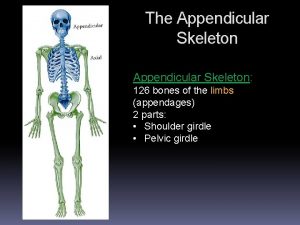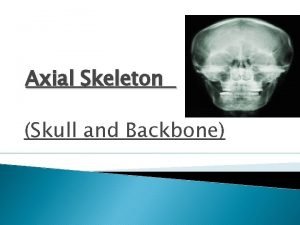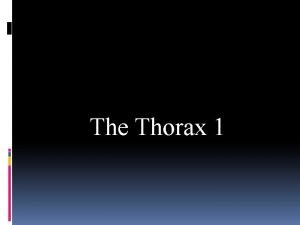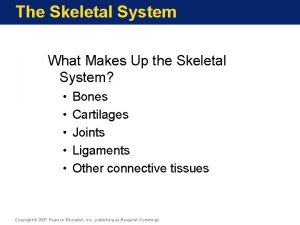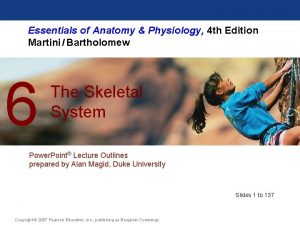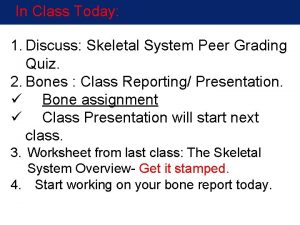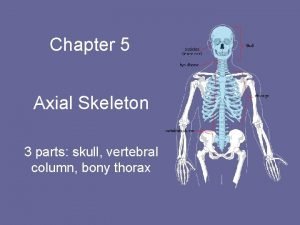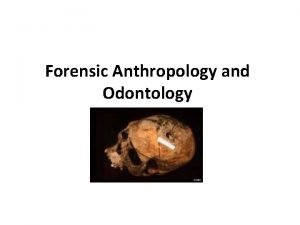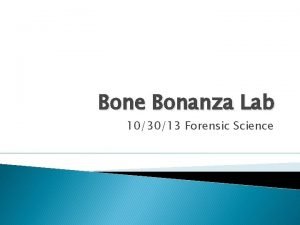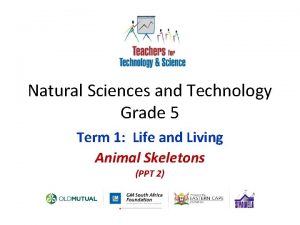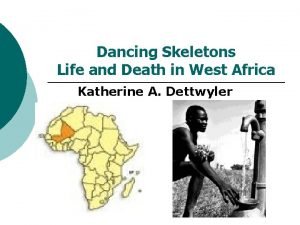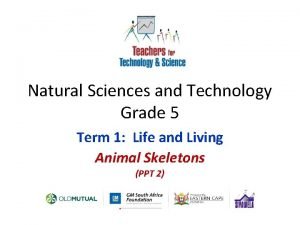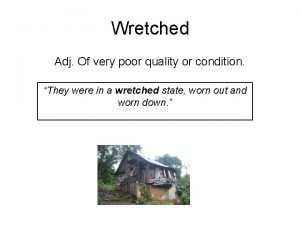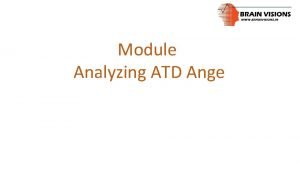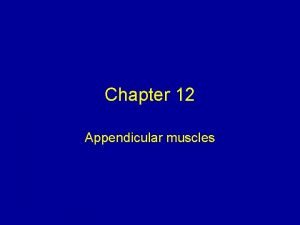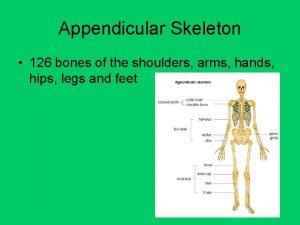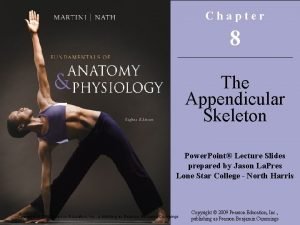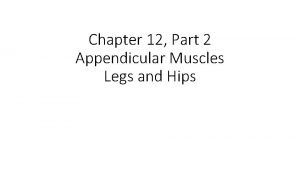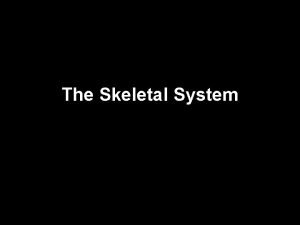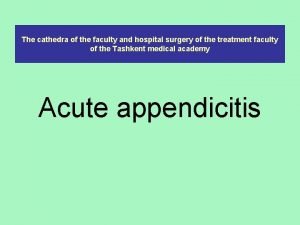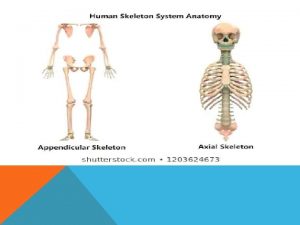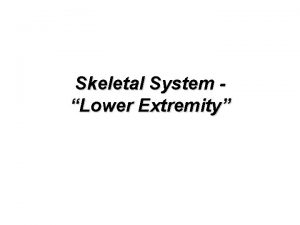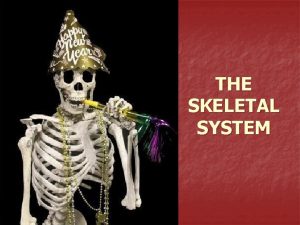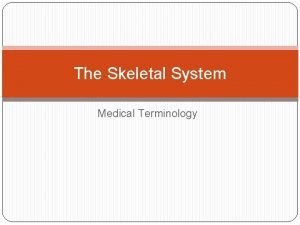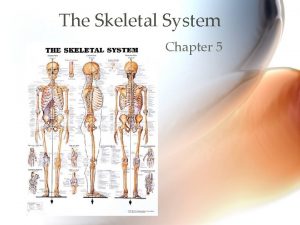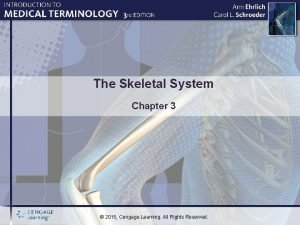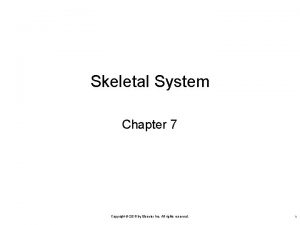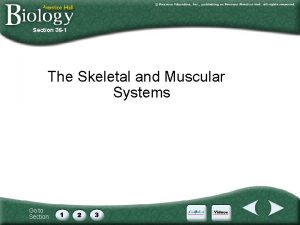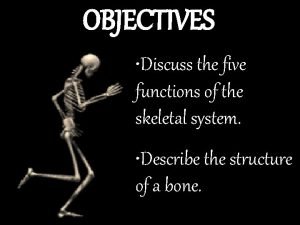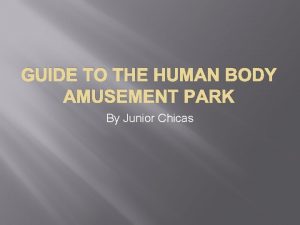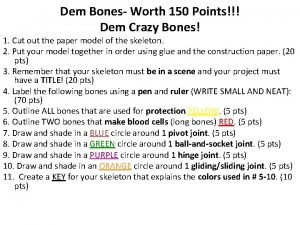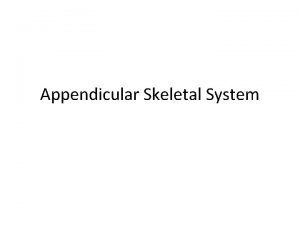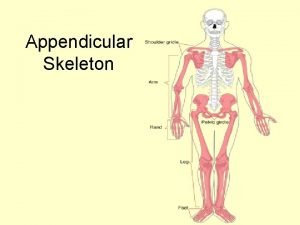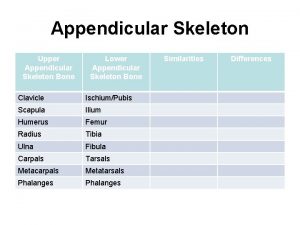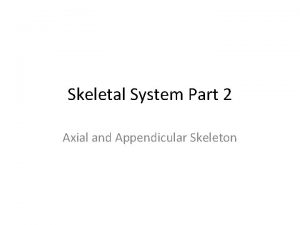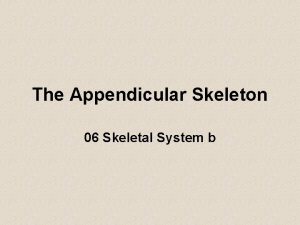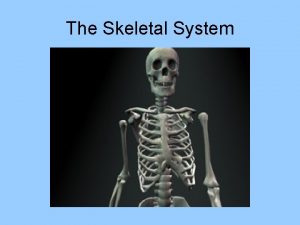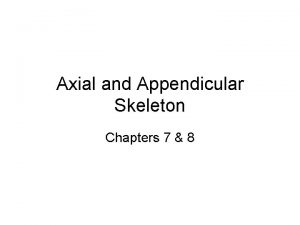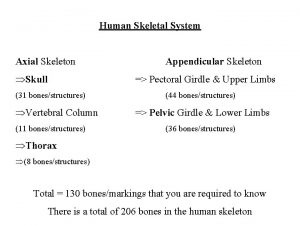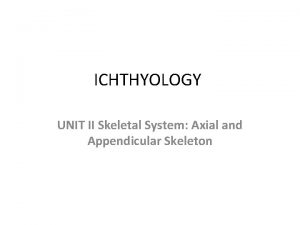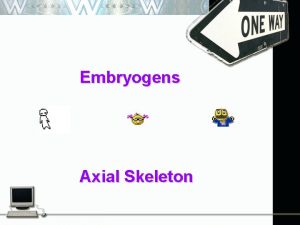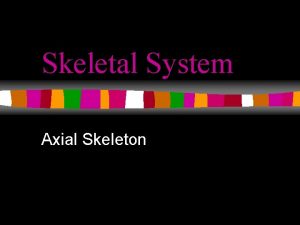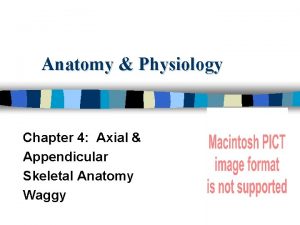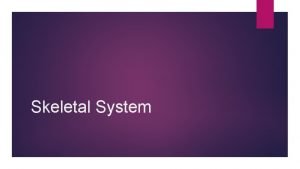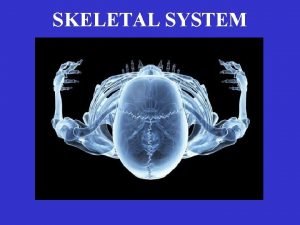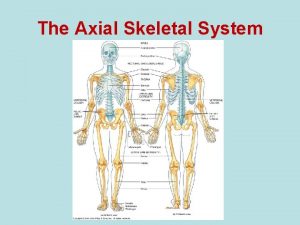Skeletal System Part 2 The Axial Appendicular Skeletons











































- Slides: 43

Skeletal System – Part 2 The Axial & Appendicular Skeletons Axial Skeleton seen in GREEN Appendicular Skeleton seen in PURPLE

The Skeleton Consists of Bones, cartilage, joints, and ligaments Composed of 206 named bones grouped into two divisions Axial skeleton (80 bones) Appendicular skeleton (126 bones)

The Axial Skeleton Formed from 80 named bones Consists of skull, vertebral column, and bony thorax Anterior View

The Axial Skeleton Posterior View

The Skull/Cranium Formed by cranial and facial bones

The Skull/Cranium The cranium and facial bones: Enclose brain Provide attachment sites for some head and neck muscles Protects and supports the eyes, nose, mouth, and ears

The Skull/Cranium The skull = 22 bones 8 cranial bones: frontal (1), parietal (2), temporal (2), occipital (1), ethmoid (1), and sphenoid (1)

The Skull/Cranium The skull = 22 bones 14 facial bones: nasal (5), maxilla (2), lacrimal (2), zygomatic (2), palatine (2), mandible(1)

The Skull/Cranium Protects and supports the brain, eyes, ears, nose, and mouth Made up of the cranium and facial bones Bones connected by sutures (immovable joints) The skull contains approximately 85 named openings Lower jaw is the largest and strongest facial bone – mandible (ONLY movable joint in skull

Special Parts of the Skull Orbits – around the eyes Nasal cavity Paranasal sinuses – lined with mucus and lighten skull Hyoid bone – ONLY bone in body that DOES NOT attach to any other bone; is the base for the tongue

The Fetal Skull bones NOT YET attached to each other Connected by cartilage Called fontanels (little fountains) Named as such because the babies pulse can be seen and felt in these ‘soft spots’

The Vertebral Column Formed from 26 bones in the adult Transmits weight of trunk to the lower limbs Surrounds and protects the spinal cord Serves as attachment sites for muscles of the neck and back Bones cushioned by intervertebral disks (cartilage)

The Vertebral Column Cervical Vertebrae – 7 Thoracic Vertebrae – 12 Lumbar Vertebrae – 5 Sacral vertebrae – 5 fused Coccyx – 4 fused

Cervical Vertebrae 7 cervical vertebrae (C 1 – C 7) – smallest and lightest vertebrae Atlas (C 1) = first vertebrae; helps us nod our head Axis (C 2) = second vertebrae; helps us turn our head

Cervical Vertebrae

Thoracic Vertebrae (T 1 – T 12) 12 bones (T 1 -T 12) All articulate (connect directly) with ribs

Lumbar Vertebrae (L 1 – L 5) 5 bones (L 1 -L 5) Bear the body’s weight

Sacrum (S 1 – S 5) Formed from 5 fused vertebrae Shapes the wall of pelvis Articulation point for hips

Coccyx Is the “tailbone” Formed from 4 fused vertebrae Offers only support to pelvic organs

Bony Thorax Forms the framework of the chest Made up of the sternum, ribs, and thoracic vertebrae Protects thoracic organs Supports shoulder girdle and upper limbs Provides attachment sites for muscles

The Bony Thorax

Sternum Formed from three sections Manubrium Body Xiphoid process

Ribs All ribs attach to vertebral column True ribs - superior 7 pairs of ribs Attach DIRECTLY to sternum by costal cartilage False ribs – inferior 5 pairs of ribs DO NOT attached directly to the sternum Ribs 11– 12 are known as floating ribs

Ribs

Disorders of the Axial Skeleton Abnormal spinal curvatures Scoliosis – an abnormal lateral curvature Kyphosis – an exaggerated thoracic curvature Lordosis – an accentuated lumbar curvature – “swayback”

Spinal Curvatures Scoliosis Kyphosis Lordosis

The Appendicular Skeleton Formed from 126 named bones Consists of pectoral girdle, pelvic girdle, and limbs

The Appendicular Skeleton Pectoral girdle (Shoulder bones) Attaches the upper limbs to the trunk Pelvic girdle (Hip bones) Attaches the lower limbs to the trunk Upper and lower limbs The appendages

The Pectoral Girdle Consists of the clavicles and the scapulas – 2 of each (1 for each arm) Allow the attachment of muscles and help with arm movement Clavicles attach to one end of the scapulae and the other end to the sternum

Pectoral Girdle Anterior View Posterior View

Clavicles Clavicle “Collarbone” Forms the shoulder joint by attaching to the manubrium of the sternum and the scapula Holds the arm away from the thorax and helps to prevent dislocation of the shoulder

Scapula “Shoulder Blades” Located between ribs 2 -7 Not directly attached to skeleton (held by muscles) Has a flat end, an acromion process (connects to clavicle), and a coracoid process (anchor arm muscles)

The Upper Limb 30 bones form EACH upper limb Grouped into bones of the Arm = humerus (longest and strongest bone of upper limbs) Forearm = radius (lateral – runs up the thumb side of the forearm) and ulna (medial and largest bone of the forearm) Hand = (27 bones); carpals (8) - wrist, metacarpals (5) - palms, phalanges (14) – fingers *each finger except for the thumb has 3 phalanges

Structures of the Humerus

Radius and Ulna

Bones of the Hand

Pelvic Girdle Attaches lower limbs to the spine 2 coxal bones (Ilium, ischium, and pubis), sacrum, and coccyx Supports soft organs Attaches to the axial skeleton Large, heavy bones Bear the weight of the upper body Female pelvis is wider than male pelvis for childbearing purposes

Bony Pelvis

Male Pelvis vs. Female Pelvis Smaller inlet Taller and more curved Larger inlet Shorter and less curved

The Lower Limb Carries the entire weight of the erect body Bones of lower limb are thicker and stronger than those of upper limb Divided into three segments Thigh = femur longest and strongest in body and patella (protects the knee) Leg = tibia (largest leg bone) and fibula Foot = tarsus ( 7 tarsal bones), metatarsals (5) and phalanges (14 – 3 per toe except for the big toe)

Structures of the Femur

Structures of the Tibia and Fibula

Bones of the Foot
 Appendicular vs axial bones
Appendicular vs axial bones What are parts of the appendicular skeleton
What are parts of the appendicular skeleton Appendicular vs axial
Appendicular vs axial Differentiate between axial and appendicular skeleton
Differentiate between axial and appendicular skeleton Xiphosternal joint
Xiphosternal joint Figure 6-2 structure of a typical bone
Figure 6-2 structure of a typical bone Figure 6-4 the skeleton axial and appendicular divisions
Figure 6-4 the skeleton axial and appendicular divisions Figure 6-4 the skeleton axial and appendicular divisions
Figure 6-4 the skeleton axial and appendicular divisions Figure 6-4 the skeleton axial and appendicular divisions
Figure 6-4 the skeleton axial and appendicular divisions Chapter 5 the skeletal system axial skeleton skull
Chapter 5 the skeletal system axial skeleton skull Chapter 5 the skeletal system axial skeleton skull
Chapter 5 the skeletal system axial skeleton skull Sue palmer recount
Sue palmer recount A text that presents one side of the topic
A text that presents one side of the topic Differences between the male and female skeleton
Differences between the male and female skeleton Bone bonanza lab answers
Bone bonanza lab answers Travel brochure examples
Travel brochure examples Maiden castle skeletons
Maiden castle skeletons Natural science grade 5 term 2
Natural science grade 5 term 2 Sue palmer explanation text
Sue palmer explanation text Dancing skeletons dettwyler
Dancing skeletons dettwyler Grade 5 social science term 1
Grade 5 social science term 1 Perambulating skeletons
Perambulating skeletons Axial suspension
Axial suspension Atd angle full form
Atd angle full form Identify the muscle
Identify the muscle Appendicular skeleton 126 bones
Appendicular skeleton 126 bones Posterior view of patella
Posterior view of patella Anatomy and physiology chapter 8 skeletal system
Anatomy and physiology chapter 8 skeletal system Appendicular muscle
Appendicular muscle Epiphyseal plate vs line
Epiphyseal plate vs line Appendicular infiltrate
Appendicular infiltrate Appendicular skeleton
Appendicular skeleton Lower extremity appendicular skeleton
Lower extremity appendicular skeleton What are the five functions of the skeletal system
What are the five functions of the skeletal system Medical terminology skeletal system
Medical terminology skeletal system Skeletal system
Skeletal system Chapter 3 the skeletal system answer key
Chapter 3 the skeletal system answer key Chapter 7 4 skeletal system
Chapter 7 4 skeletal system Chapter 5 the skeletal system figure 5-13
Chapter 5 the skeletal system figure 5-13 Section 36-1 the skeletal system
Section 36-1 the skeletal system What are the five functions of the skeletal system?
What are the five functions of the skeletal system? Human body theme park
Human body theme park Dem crazy bones skeleton template
Dem crazy bones skeleton template Chapter 6 skeletal system
Chapter 6 skeletal system

